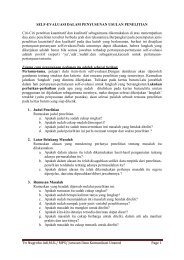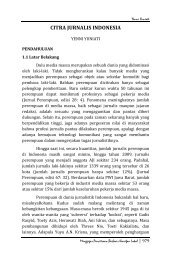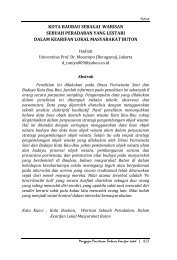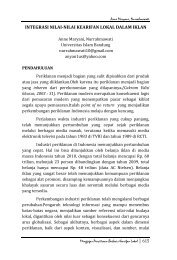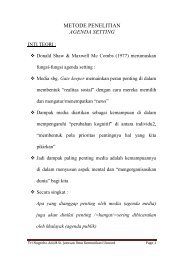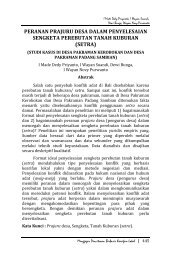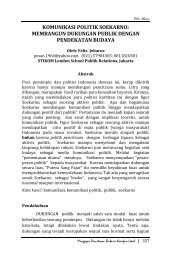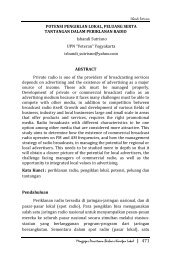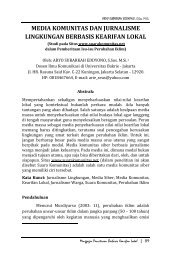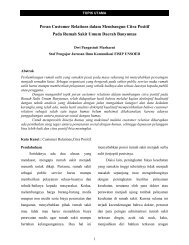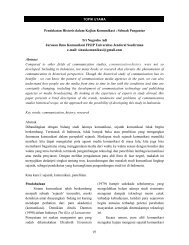New Vocabularies in Film Semiotics
New Vocabularies in Film Semiotics
New Vocabularies in Film Semiotics
You also want an ePaper? Increase the reach of your titles
YUMPU automatically turns print PDFs into web optimized ePapers that Google loves.
30 CINE-SEMIOLOGY<br />
Spottiswoode’s Grammar of <strong>Film</strong> (1935) and Robert Bataille’s Grammaire<br />
C<strong>in</strong>égraphique (1947). In other pre-semiotic discussions, the film-language<br />
metaphor became <strong>in</strong>timately l<strong>in</strong>ked to the cognate tropes of the “camera<br />
pen” (Astruc) and “film writ<strong>in</strong>g.” In post-war France, especially, this<br />
“graphological” figure, as we shall see <strong>in</strong> some detail <strong>in</strong> Part V, became a<br />
key structur<strong>in</strong>g concept subtend<strong>in</strong>g film theory and criticism.<br />
THE CINEMATIC SIGN<br />
It was only with the advent of structuralism and semiotics <strong>in</strong> the 1960s,<br />
however, that the film-language concept was explored <strong>in</strong> depth by theorists<br />
like Umberto Eco, Pier Paolo Pasol<strong>in</strong>i and Christian Metz. Much of the<br />
early discussion had to do with the nature of the filmic analogon. The<br />
<strong>in</strong>itial tendency was to contrast the arbitrary signs of natural language with<br />
the motivated, iconic signs of the c<strong>in</strong>ema. In his earliest work, Metz<br />
emphasized both the analogical nature of the filmic image as well as the<br />
causal photo-chemical connection between representation and prototype.<br />
But <strong>in</strong> a 1970 article, “Beyond Analogy, the Image,” Metz nuanced his<br />
argument, po<strong>in</strong>t<strong>in</strong>g out that to see an image as simply analogical is to forget<br />
that it can be analogical and motivated <strong>in</strong> some respects and yet be<br />
arbitrary <strong>in</strong> other respects. Representational images, <strong>in</strong> sum, can<br />
themselves be coded (Metz 1972).<br />
Another important figure <strong>in</strong> the theorization of the image was Roland<br />
Barthes. For Barthes, the image is characterized by POLYSEMY (literally,<br />
many “semes” or mean<strong>in</strong>gs), i.e. it shares with other signs, <strong>in</strong>clud<strong>in</strong>g<br />
l<strong>in</strong>guistic signs, the property of be<strong>in</strong>g open to multiple significations. The<br />
accompany<strong>in</strong>g captions of photographs, or written materials <strong>in</strong> a film,<br />
Barthes suggested <strong>in</strong> “Rhetoric of the Image,” often function as<br />
ANCHORAGE, i.e. as a verbal device which “discipl<strong>in</strong>es” polysemy by<br />
coax<strong>in</strong>g the observer’s perception <strong>in</strong>to a preferred “read<strong>in</strong>g” of the image.<br />
The anchor<strong>in</strong>g words “fix the float<strong>in</strong>g cha<strong>in</strong> of signifieds”; they guide the<br />
viewer among the different possible significations of a visual representation.<br />
Barthes gives the example of an advertisement show<strong>in</strong>g fruits scattered<br />
around a ladder, an image that might connote “paucity of harvest,”<br />
“damage due to high w<strong>in</strong>ds,” or “freshness”; the caption “as if from your<br />
own garden” anchors the mean<strong>in</strong>g of “freshness” (Barthes 1977). In<br />
Camera Lucida (1980) Barthes theorizes the specific pleasures provoked by<br />
the “force of silence and immobility” typical of still photography. He<br />
speaks of two ways of apprehend<strong>in</strong>g the same photograph: the STUDIUM<br />
deploys objective signs and coded <strong>in</strong>formation, while the PUNCTUM<br />
triggers the play of chance and subjective association, <strong>in</strong>vest<strong>in</strong>g the photo<br />
with personal desire.<br />
Other analysts also took up the Peircean trichotomy. Peter<br />
Wollen argued <strong>in</strong> Signs and Mean<strong>in</strong>g <strong>in</strong> the C<strong>in</strong>ema (1969) that c<strong>in</strong>ema



